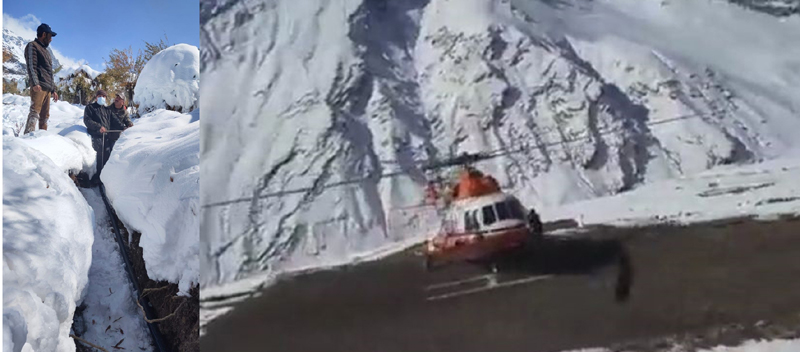UT admn implementing JJM despite extreme climatic conditions
*Choppers being used for transportation of pipes to remote areas
Mohinder Verma
JAMMU, Oct 30: About 75 years after the independence, several habitations of Union Territory of Ladakh have started getting tap water supply as despite challenging terrain and extreme climatic conditions the administration is leaving no stone unturned to implement the Jal Jeevan Mission (JJM) of the Government of India.
The Jal Jeevan Mission is envisioned to provide safe and adequate drinking water through individual household tap connections by 2024 to all households in rural India by way of development of in-village piped water supply infrastructure and reliable drinking water sources and/or augmentation of existing sources to provide long-term sustainability of water supply system.
There are a total of 44076 households in Ladakh and till August 15, 2019 only 1414 households were covered under the Jal Jeevan Mission because of varied reasons. However, since the formation of Union Territory the implementation of Mission has picked up remarkably and this can be gauged from the official figures which reveal that as on today 9423 households have been provided tap water connections.
“For the first time since independence, all the households in 15 villages—three in Kargil and 12 in Leh district have been provided tap water connections under the Mission by the Union Territory administration and work stands allotted in respect of remaining villages and by August 15 next year all the 44076 households will have tap water connections”, Ajeet Kumar Sahu, Mission Director Jal Jeevan Mission and Commissioner/Secretary, Public Health Engineering Department of the Union Territory of Ladakh told EXCELSIOR.
The intensity of pace of work on the implementation of Mission can be gauged from the fact that even adequate arrangements for airlifting of High-Density Polythene (HDPE) pipes to the remote habitations have been made by the UT administration. Till date, such pipes have been airlifted to Dipling village, which is situated at an altitude of 4000 meter above the sea level.
“The engineers with the active assistance of villagers are working with full enthusiasm even in -12 degrees temperature and we are hopeful of meeting the target of August 15, 2022”, Sahu said, adding “in order to avoid freezing of water supply lines we are laying the HDPE piles below the frost line and adequate arrangements have been made to ensure that temperature remains above zero degree at the storage channels”.
Two days back Man-Merak village, which is situated near Pangong Lake, received tap water supply and there was jubilation in the area as earlier the residents used to travel miles on foot to get drinking water.
The Jal Jeevan Mission Twitter handle said: “The remote inhabitants of Ladakh will soon have tap water supply in their homes. Despite challenging terrain and temperature at -12 degrees, work is ongoing at Dipling village, at an altitude of 4,000 meter above sea level. The HDPE pipes are being transported through a helicopter”.
“We knew that it is a difficult task and it was a testing time for our abilities. Proud that the Jal Jeevan Mission soldiers are cracking every toughest test and taking the pipeline to such places where weather makes everything impossible”, Union Minister of Jal Shakti Gajendra Singh Shekhawat has written on Micro-blogging site.
Even Commerce and Industry Minister Piyush Goyal has mentioned on Twitter: “Under the leadership of Prime Minister Narendra Modi, Jal Jeevan Mission is being implemented in Dipling, a village situated at an altitude of 4000 meter above the sea level in Ladakh”.
Disclosing that there were several hurdles in the implementation of Jal Jeevan Mission, sources said, “everybody right from engineers to the villagers was nursing an impression that laying of pipes during winter months is almost impossible but to change this mind-set the Mission Director of Jal Jeevan Mission constituted different committees at block and village level and now people are themselves actively participating in the execution of work”.
Similarly, there were some technological issues but with the active cooperation of engineers and locals the same were resolved for smooth implementation of Jal Jeevan Mission. “Even a company which was entrusted the task of laying pipes had expressed inability to do the work during extreme climatic conditions but the administration made the same possible by overcoming all the difficulties”, sources said.


